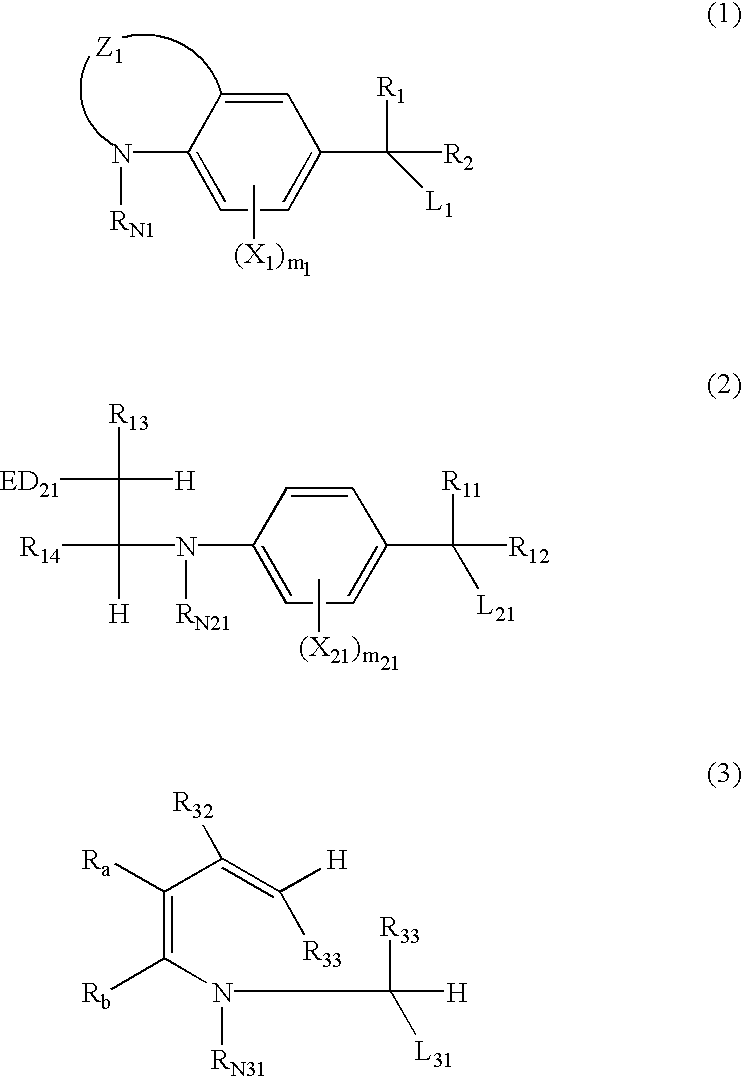Silver halide photosensitive material
a silver halide and photosensitive technology, applied in the field of photosensitive materials, can solve the problems of compound inability to achieve ideal high speed and the idea of high photographic speed has not yet been realized, and achieve the effect of enhancing photographic speed
- Summary
- Abstract
- Description
- Claims
- Application Information
AI Technical Summary
Benefits of technology
Problems solved by technology
Method used
Image
Examples
example 1
Silver halide emulsions Em-A, Em-AP1, Em-AP2, and Em-ARP1 to Em-ARP12 were prepared by the following methods.
(Em-A)
42.2 liter (hereinafter liter is also referred to as “L”) of an aqueous solution containing 31.7 g of a low-molecular-weight gelatin of 15,000 molecular weight and converted to phthalate at a ratio of 97% and 31.7 g of KBr was vigorously agitated while maintaining the temperature at 35° C. 1583 milliliter (hereinafter milliliter is also referred to as “mL”) of an aqueous solution containing 316.7 g of AgNO3 and 1583 mL of an aqueous solution containing 221.5 g of KBr and 52.7 g of a low-molecular-weight gelatin whose molecular weight was 15,000 were added by the double jet method over a period of 1 min. Immediately after the completion of the addition, 52.8 g of KBr was added, 2485 mL of an aqueous solution containing 398.2 g of AgNO3 and 2485 mL of an aqueous solution containing 291.1 g of KBr were added by the double jet method over a period of 2 min. Immediately afte...
example 2
Silver halide emulsions Em-Q, Em-QP1, Em-QP2, and Em-QRP1 to Em-QRP10 were prepared by the following methods.
(Em-Q)
1,200 mL of an aqueous solution containing 0.38 g of a gelatin of 10,000 molecular weight and converted to phthalate at a ratio of 97%, and 0.99 g of KBr were vigorously stirred at 60° C., while adjusting the pH thereof at 2. An aqueous solution containing 1.96 g of AgNO3, an aqueous solution containing 1.97 g of KBr, and 0.172 g of KI were added over 30 sec by the double jet method. After the ripening, 12.8 g of trimellitated gelatin whose amino groups were chemically modified with trimellitic acid, containing 35 μmol of methionine per g thereof and having a molecular weight of 100,000 was added. After the pH was adjusted to 5.9, 2.99 g of KBr and 6.2 g of NaCl were added. 60.7 mL of an aqueous solution containing 27.3 g of AgNO3 and an aqueous KBr solution were added over 35 min by the double jet method. During the addition, the silver potential was maintained at −50 ...
example 3
(Em-A; Emulsion for High-Speed Blue-Sensitive Layer) The same emulsion as prepared in Example 1.
(Em-B; Emulsion for Low-Speed Blue-Sensitive Layer)
1,192 mL of an aqueous solution containing 0.96 g of low-molecular weight gelatin and 0.9 g of KBr were vigorously stirred at 40° C. 37.5 mL of an aqueous solution containing 1.49 g of AgNO3 and 37.5 mL of an aqueous solution containing 1.5 g of KBr were added over 30 sec by the double jet method. After 1.2 g of KBr were added, the temperature was raised to 75° C. to ripen the material. After the ripening, 30 g of trimellitated gelatin whose amino groups were chemically modified with trimellitic acid and whose molecular weight was 100,000 were added, and the pH was adjusted to 7.6 mg of thiourea dioxide were added. 116 mL of an aqueous solution containing 29 g of AgNO3 and an aqueous KBr solution were added by the double jet method while the flow rate was accelerated such that the final flow rate was 3 times the initial flow rate. During ...
PUM
| Property | Measurement | Unit |
|---|---|---|
| aspect ratio | aaaaa | aaaaa |
| pKa | aaaaa | aaaaa |
| pKa | aaaaa | aaaaa |
Abstract
Description
Claims
Application Information
 Login to View More
Login to View More - R&D
- Intellectual Property
- Life Sciences
- Materials
- Tech Scout
- Unparalleled Data Quality
- Higher Quality Content
- 60% Fewer Hallucinations
Browse by: Latest US Patents, China's latest patents, Technical Efficacy Thesaurus, Application Domain, Technology Topic, Popular Technical Reports.
© 2025 PatSnap. All rights reserved.Legal|Privacy policy|Modern Slavery Act Transparency Statement|Sitemap|About US| Contact US: help@patsnap.com



